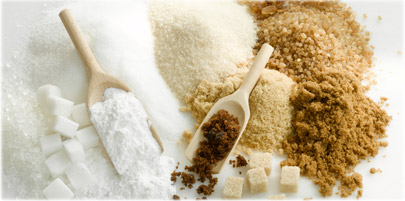I don’t know about you, but I like a little sugar in my life. Both of the sweet lovin’ kind AND the dessert.
There are lots of different ways you can impart sweetness into dishes, all of which have different flavor profiles that can accent and highlight other ingredients OR stand alone to showcase the brilliance of the different variations of sugar. Even if a recipe calls for classic white sugar, you can always change things up with a different sweetener to make the dish sing. Here are 4 different ones you can think about using in your next cooking adventure.
1. Granulated Sugar (white, brown, cane). We’ve all had this kind of sweet. Most baking recipes call for some variation of this kind of sweetener which is harvested from sugar cane and more commonly, sugar beets. White refined sugar certainly has its drawbacks including bleach, GMO (genetically modified organisms) and correlational links to obesity, so many home cooks steer toward brown or organic cane sugar because it maintains the liquid/dry ratio of baked goods as well as the mild flavor of white sugar. Brown or cane sugar may make your dish slightly darker in colour which isn’t necessarily a bad thing, unless you want a crisp, white look to your finished dish.
2. Honey. One of the most easily accessible and historically used sweeteners in human is history, is honey. Harvested by bees (and their keepers), this classic sugar is natural and used extensively in cooking savory as well as sweet dishes and can even be drizzled over fresh fruit as a Summer afternoon snack, over fresh baked bread, or into beverages like tea or cocktails. It’s flavor varies greatly with different varieties as well as the flowers the pollen is gathered from, but it’s typically sweet, a little musty and is incredibly full bodied.
Note: Store bought honey does not taste anything like the farm fresh kind. Read this article to find out why you should aim for Farmer’s Market honey over the kind you get in most grocery stores.
3. Molasses. This type of sweetener comes from the same plants as regular granulated sugar – sugar cane and sugar beets – but is a viscous by-product that is produced by refining those plants and cutting, boiling, straining, skimming and reboiling them. It tends to be sweet, thick and slightly bitter in taste and is often used in baking where there is sharper flavors like ginger, allspice and coconut, or even savory ones like lamb and beef. It works well as a replacement for brown sugar as well.
4. Syrups (Pure Maple, Agave). These two types of sweeteners should probably have their own category since one is natural (pure maple) while the other is a biproduct from the starch of the giant pineapple-like, root bulb (agave).
In fact, most agave syrups consist mainly of high fructose corn syrup, despite its health claims. Many foodies and healthy eaters have taken up the agave syrup torch because of these claims but research shows it’s actually highly hazardous to our health. The same can be said of artificial maple syrups – check the ingredients. If you see hydrogenated or fructose, steer clear.
Pure maple syrup on the other hand, is a natural liquid sap that maple trees produce on a yearly basis. The trees are tapped when the season arrives and allowed to leak out until dry. Water is then boiled out of the sap, leaving the producer with a thick, sweet liquid known as maple syrup. While more expensive than agave or other sugars, if you like the deep flavor of maple, this could be the sugar for you.
Choosing a sweetener for your dish all depends on the finished look and flavor you’re aiming for, as well as the other ingredients you’re cooking. What works? What doesn’t? It’s all about experimentation and with that … new wow moments!
Do you cook with any of these particular sweeteners? Prefer one over the others? Is there any sweeteners you steer clear of? Did we miss any you like to use? Share your “sweet” thoughts with us below or on the Facebook Page! We’d love to hear from you!
The Culinary Exchange can be found on Facebook, Twitter, Instagram, Pinterest, Google+ and YouTube.
Come on! Follow Along!






Sweet Post! Nicely written.
Thanks Catherine and thanks for stopping by to join the conversation!